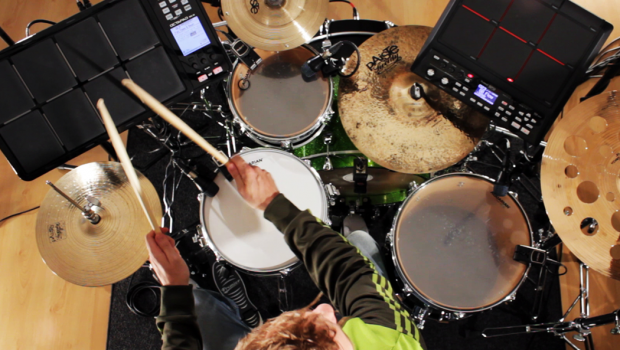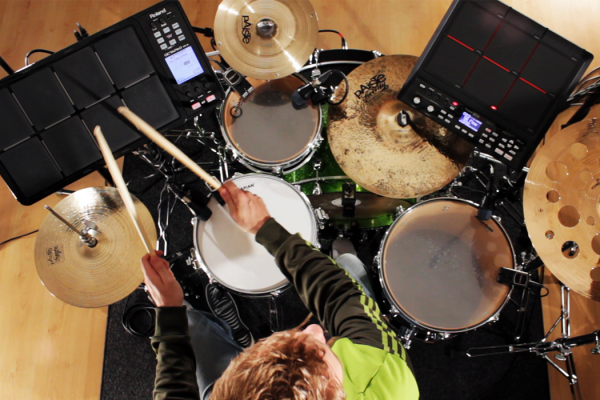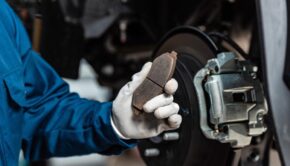Beginner’s Guide To Drum Triggers
Drum triggers are not new technology, yet they are certainly becoming more pervasive within the live touring circuit for many styles of music.
If you’re unfamiliar with the term ‘drum trigger’ you might be wondering what it means, and how the technology works. An acoustic drum trigger is a device that clamps onto the hoop of a drum, and reads vibrations of the drumhead when it is struck. It is thus ‘triggered’, and sends information to the drum trigger module that is able to play an additional, electronic sound simultaneously.
We will get more into the technical specific information later on, with a more detailed rundown of the processes that take place, but for now let’s take a look at exactly why modern drummers frequently use drum triggers for contemporary music performances.
Limitless Opportunities For Sounds
Drum triggers bridge the gap between acoustic and electronic drum set, and allow drummers of every style to take advantage of electronic samples whilst playing a conventional acoustic drum set.
Much like how the guitar can be played in several ways, drum triggers provide drummers with the freedom to explore more musical avenues.
By incorporating acoustic drum triggers to a live performance, a drummer is able to have any sound blended with his acoustic drums. This is truly remarkable, because drummers are typically restricted to the limited tones that acoustic drums and cymbals offer.
A drummer is able to load any sound into a drum module, or ‘brain’, which can be triggered with the strike of a drumhead. The potential for what can be achieved through drum triggers is effectively limitless. If you can think of a sound, you can trigger it and play it.
Perfect For All Styles Of Music
The ability to expand and broaden upon musical horizons means drum triggering opens up new creative opportunities for drummers of all styles.
pop, rock, dance, hip-hop, metal and RnB drummers can all take advantage of drum triggers to explore new creative realms and find sounds that build upon existing sonic conventions.
Drum triggering is experiencing a revival within modern music, because drummers of all styles are able to be equipped with a greater range of sounds to enhance a performance.
Triggers are velocity sensitive, which means they can detect how hard you play in order for the output sound to accurately characterise your playing. If you want to adjust this to achieve exactly the same sound regardless of playing velocities, you are able to do this also.
Consistent Live Sound
A huge advantage to drum triggering is that it is a dream to work with for professional sound technicians of touring live acts. Every venue has a different PA, and the rooms have naturally differing acoustic properties, which means it’s often challenging to reproduce a desired sound with microphones alone.
Drum triggering produces a clean reproduction of a studio quality sample that makes for clearer and punchier sounds with less hassle. It’s an immediate solution that will make drums sound great at each venue no matter what the acoustics are like.
Reproduce Studio Versions Live
Drummers of all musical styles are able to replicate the authentic drum tones that appear on a record in order to reproduce true-to-life versions of songs that fans expect to hear at shows.
This necessary aspect of modern music is is echoed by Adele’s live drummer Derrick Wright: “Today’s music has changed. It’s evolving. There’s a lot of electronics in the music. You’ve got to stay authentic to the music and how it comes out on the records.”
How Do Triggers Work Exactly?
Drum triggers sense vibrations either from the drumhead or rim (if the trigger has dual functionality), and then translate information to the drum module in order for it to play a sound. But it’s not quite as simple as it sounds!
Drum trigger units use ‘piezo technology’ which detects vibrations on the drumhead, and is forced to create a small amount of voltage. This voltage is then sent to the trigger-to-MIDI converter, which is then interpreted by the drum module as MIDI information. With this the sound source is then able to produce sound.
The most popular drum triggers on the drum market are small, lightweight, unobtrusive devices that attach to the hoop of a drum and do not need any external power. They either use a quarter inch jack or XLR that goes straight into the drum module in order for it to convert the information into MIDI.
In addition to a drum trigger device, you will also need a drum module, or ‘brain’ as they are commonly called, which will turn the trigger pulse into MIDI information. This is the expensive part of triggering. A drum trigger itself is relatively inexpensive, but the drum module is what will set you back more.
Drum modules are most commonly seen on electronic drum sets. They translate the information from the rubber cymbals and mesh pads into MIDI technology, and then into sound. If you already have an electronic drum set, the drum module will likely be able to function as a trigger interface.
Flagship drum sample pads such as Roland’s SPD-SX are able to accommodate two drum triggers to use for live performances, in addition to having their own assignable velocity-sensitive pads that you are able to load samples into.
Are There Any Drawbacks Of Drum Triggers?
Drum Triggering with hybrid drum setups is immensely popular within the live touring circuit. We have discussed their benefits, notably the way in which they are able to equip drummers with infinite sounds for performances. But are there any downsides or drawbacks to using drum triggers?
Modern drum triggers for the most part are less susceptible to issues that they experienced in the past. For example poor latency could mean samples were played out-of-sync with the drummer, and although it’s less common, it could happen if the quality of cables are poor, or if there are any existing issues with the drum interface.
Anyone who has ever used triggers might be aware of potential issues surrounding mistriggering, either from note dropouts or the trigger misfiring with double triggers. Sometimes it is unavoidable, and with technology you are often at the mercy of whether it decides to cooperate with you! If you are playing metal there is a greater chance for mistriggering as opposed to pop because there will be significantly more kick drum hits to be triggers, and often in rapid succession.
Final Thoughts
Modern music demands more from professional touring drummers, who can now be seen employing hybrid setups on arena stages around the world.
Incorporating electronics within an acoustic drum setup adds tools to a drummer’s armoury, and enhances a drummer’s value as a musician in addition to what can be accomplished behind the drum set.
Here is a video of Aric Improta; a master-class in pushing musical boundaries with an incredible level of creativity. Improta utilises electronics within an acoustic setup to achieve what people assumed would never be possible from a drummer. He proves that if you can think of sounds to integrate, you can make it a reality!
If you wish to explore a wider range of sounds in conjunction with your existing acoustic drum set, drum triggers are the perfect solution for you in order to broaden your sonic horizons that will inspire creativity and motivation for you to play!

















